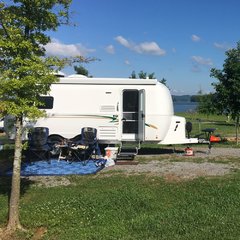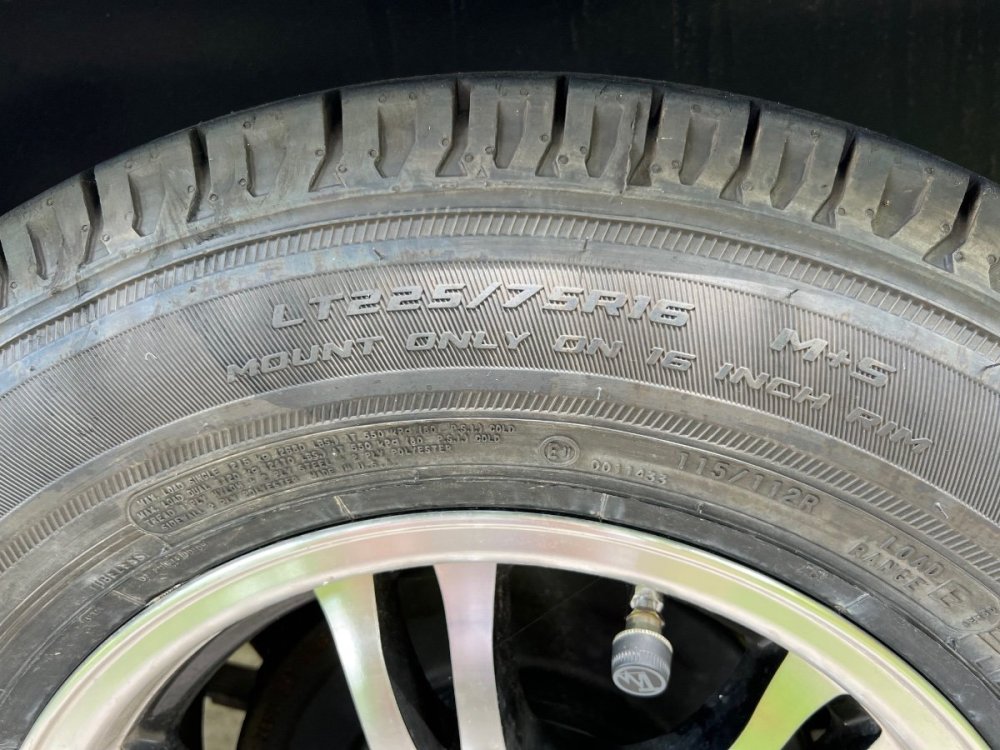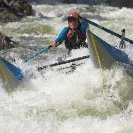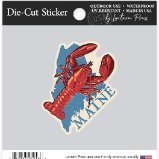Search the Community
Showing results for 'tpms'.
-
https://olivertraveltrailers.com/forums/topic/2363-how-to-tire-pressure-placard/ The best thing is to measure your axle weight on a truck scale and go from that chart. 60 should be pretty close for an LE1. Keep an eye on tire temp, if it gets too warm that is a big indicator that the pressure is low. Do you have a TPMS? It is a critical safety device IMHO, especially with a single axle. Mine has screw on sensors, and when getting ready to leave in the morning I “wake up” each one with a couple of raps from my finger so they transmit today’s value, not the one from when I arrived, in case one picked up a nail and was quietly deflating overnight. That is better than having it alert you a mile down a busy highway… they take a while to update, since they just send out a brief radio signal occasionally, perhaps as long as a couple of minutes after waking. https://www.underhoodservice.com/tpms-radio-frequency-theory-and-operation/ John Davies Spokane WA
-
"For trailer leveling, I use the LevelMate Pro by LogicBlue. I purchased it and had Oliver install it for me on delivery day in the closet because I was not confident that the attaching screws would be too long and pierce the visible side of the fiberglass. This system works like a charm, and I have verified its accuracy using a 4' level. I also use the Andersen leveling wedges, the Andersen trailer jack blocks, and heavy rubber wheel chocks I purchased at Northern Tool." I have the same leveling tool in the box still. Good to know that they can install it on delivery day. I am a member of the Facebook Oliver owners page and that's been helpful. Thanks for your comments. The forum members have been very helpful since my first post saying my wife is hesitant to buy because of the cost. I have the TST tpms. I will get the other items you mentioned. Thanks again. John
-
John, have you ever towed and slept in any trailer beside your Coleman? If not you should consider renting a travel trailer for at least a long weekend. Pick one with full amenities including black tank. This will give you plenty of learning time including how to dump 😳 You can poke around inside all the cubbies and compartments and identify parts. You most likely will see lots of raw plywood and junk cabinets held together with a few screws and lots of staples. You will also see poor quality windows and little to no insulation, cheap weak steel frame (most likely rusty) and poor tires and suspension. All this will make you appreciate the fine build quality of your new Ollie, and you will have a head start figuring out the basic plumbing, heating and electrical systems. If you run into something confusing while camping in it, you can always take some pics and post here in the forums. Just remember to be where your phone works well… https://rvshare.com/rv-rental/beaverton/or?location=Beaverton%2C OR&lat=45.4887993&lng=-122.8013332&cancellation_policy=Flexible&from_year=2016&max_length=26&min_length=18&rv_class=Travel Trailer&towing_weight=9200 If you don’t rent one, visit a few dealers and ask to just look around on your own to see their details. Or go here in a little over a week: 2022 Portland RV Show The main thing is to not stress too much. My sister is just a few miles from you. She bought a 5x7 teardrop a few years ago and she is still pretty much completely clueless about, well, everything. But she does enjoy it a lot, even though she and her husband have to push it back into campsites by hand…😳 Just last month they were doing that, blocking the access road, and two husky young men jumped out of their truck and took over😬. They had it nicely positioned in a few seconds. There are some jerks here and there, but also lots of helpful folks; on the whole everybody you meet will be interested in your Ollie. Don’t feel alone! If your Expedition is not completely up to date on maintenance, get that done in the next month. Change drive train fluids, make sure the tires and brakes are fresh and good, have a load test done on the battery. A five year old battery and tires are “aged out” and more likely to fail. It is best to change them rather than have to deal with a failure in the middle of nowhere. Have the entire vehicle looked over before your momentous looong road trip. Buy a TPMS for the trailer and install it promptly, and make sure your Ollie tires are set to around 50 psi at most. John Davies Spokane WA
-

Tire pressure confusion - Legacy Elite 2 POLL
mossemi replied to John E Davies's topic in Towing an Oliver
I have been running my stock Michelin LT tires at about 50 lbs. I will add that at 60-65 mph my pressure does increase 3-5 lbs. after 10 minutes of drive time. The thing I would like to mention, especially for new TPMS users is the effect of sunshine on tire temperatures. For example, yesterday while driving north out of Florida, the curbside tires were running about 4 degrees warmer than the street side. And of course that changes in the afternoon when the sun shines on the street side. Mossey -

Tire pressure confusion - Legacy Elite 2 POLL
Mike and Carol replied to John E Davies's topic in Towing an Oliver
When you pick up your trailer the tires should be at the new recommended pressure (probably 55psi, not the old 80psi). We’ve used 55 for thousands of miles and 50 for thousands of miles. Both seem to be much better than the old 80psi which we used our first year. We watch pressure and temperature on our TPMS and both increase in the heat and decrease in extreme cold. No issues at either 50 or 55. Mike -
Tire pressure confusion - Legacy Elite 2 POLL
John Welte replied to John E Davies's topic in Towing an Oliver
"No noticeable temp increases." When I used my TST tpms this summer on my pop up trailer, I saw an increase in the temperature that stabilized. I ran the tires at 50 and they increased to 59. Temperature was not worrisome. I will be towing our Oliver in November with a low weight as it will be new. Any idea what we should air it up to? -

Tire pressure confusion - Legacy Elite 2 POLL
Hokieman replied to John E Davies's topic in Towing an Oliver
Reminder that replying to the OP is useful, however it is not responding to the poll. Please participate in the poll by checking the box and submitting your vote. It will be useful to all if we can see where we are, and the results might be beneficial to Oliver, if we can get enough data points. The placard decal on 2021 Hull 797 is exactly the same as JD’s 2017. I’ve already voted above, but I run 45psi, check frequently with digital temp gun. I have a TPMS. I have tested the tire pressure several times by running them up to 60 psi for awhile on the highway, measuring temps, then airing down to 45, and checking temps again at next rest stop. No noticeable temp increases. If you are reluctant to reduce psi this low, you could try this test yourself. If your tires do not increase in temperature, your data confirms you have made the right choice. And more importantly (as JD pointed out), it is in accordance with the tire OEM. Based on JD’s reported good performance, I’m going to try lowering to 42 psi. Running this low may not be for everyone, as we all run at different weights, speeds, and road conditions. -

Tire pressure confusion - Legacy Elite 2 POLL
ScubaRx replied to John E Davies's topic in Towing an Oliver
I keep the tires on the Outlaw Oliver, Hull #050 set between 60-65 psi. I formerly ran them all at 80 psi. I think that is too high. As for running them at 55 psi, I think that is fine for most owners. The reason I run more is our trailer is heavier than most all the others (raised bed option, twin 5200 pound axles, 10 ply all steel tires, disc brakes). As has been said MANY times in the past, everyone should buy and install a tire pressure monitoring system (TPMS). There are many brands available, Do your own research and select one based on your personal needs and wants.- 58 replies
-
- 11
-

-
These are ten ply TRUCK tires, they are supposed to be adjusted for the weight carried by each tire. A 7500 pound HD truck carrying 2500 pounds of cargo needs 80 psi in its rear tires because each tire is so very heavily loaded. (The front ones can run lower, about 50). One Ollie LE2 axle at maximum trailer weight of 7000 pounds has just 2700 pounds shared between both tires. So the pressure should be lowered to an appropriate level. The air supports the load, not the sidewalks. Hard tires don’t flex over bumps and potholes! Your suspension only moves up maybe an inch before the axle hits the frame. So the tires are a very important part of how it absorbs road shocks. If the Ollie is lightly loaded, hard tires make it even worse. https://olivertraveltrailers.com/forums/topic/2363-how-to-tire-pressure-placard/ A TPMS is a very important safety tool, get one ASAP so you know if a tire picks up a nail and starts to deflate! You both will feel a lot better knowing all your tires are set correctly and holding air. Does the new owners manual show a load/ pressure chart for the Cooper tires? There is no need to include all the garbage general information about tires, that is all easily found with a simple Google search. What is needed is inflation information specific for this trailer. For years they were delivering these trailers at 80 psi and it was wrecking the interiors! Cabinet doors falling open, drawers breaking, cargo getting flung around 😤. TVs breaking! This is a pet peeve of mine for five years and counting, thus the exclamation points😬!!! FYI LE owners should run “about” 50 psi. If you drive long distances on slow speed, seriously potholed dirt roads you need to lower the truck and trailer tire pressures. Or else creep along at a walking pace. John Davies Spokane WA
-
After more than a year, the TV stabilizer shocks have worked as far as not letting the TV unclip and fall down while towing. I suspect the noodle stabilizers do help a bit to reduce various stresses on the bracket and surrounding fiberglass by keeping it from bouncing around, but proper inflation of the tires is probably much more effective and important to everything else in the trailer as @John E Daviespoints out. I run all my tires at 50 psi with a tpms, so not quite as cushy as 42 psi, but much less than when they came out of the factory. I think the best we can all do is soften up the tires and make sure everything is tied down and secured while towing - but it's still like putting the trailer and it's contents through an earthquake every time it's out on the road - so things are going to happen...
-
When I see stuff like that, my first question is how much pressure do you have in your tires? On an LE2, more than 50 psi will beat up your trailer and everything inside it. I run 42 psi (with a TPMS). I also removed my (fixed mount) tv the day after I got back from Tennessee 😬 That big crack might be repairable by removing the tv from the mount and epoxying a big aluminum plate there. John Davies Spokane WA
-
Have about 2000 miles towing the Oliver now. As expected, the Sierra HD pulls just fine. We are using the multipro compatible hitch from B&W. So if I drop the tailgate step, it won't nail the hitch. More stable in every way than the Lincoln was, except maybe a little bouncier when I hit the "oh shoot" sized bumps. That is largely due to no longer using the Andersen hitch in my mind. Air bags aren't necessary but they would probably help. Moving from an SUV, we are glad to no longer hear the hitch clanking around in the receiver. 20lbs propane tanks fit under the Diamondback HD cover, but they need to be opened to transport the 30 pounders. As far as electrical doodads: Our "invisible trailer" camera remains on backorder due to COVID-19 (but at the same time GMC has revised the part number twice) - so still using the wireless camera setup from the factory. The TPMS system works great, so that is at least one less box in the truck. Only downside is it is only viewable in the NAV screen. So I have three screens in my truck: center gauge cluster, rear view mirror, and the NAV. I have three pieces of fairly critical information while towing: TPMS, Rear Camera, and Phone based maps. All three of those have to share the NAV screen, despite there being other logical places to put them. I can see my truck's TPMS on the center of the gauge cluster, but not the trailer. Supposedly GM can over the air update and fix all this -- I am not holding my breath. Since the firmware I see on my truck was released, I think Tesla has probably dropped 10 fairly substantive updates. The lane change camera system is pretty nice, but so are the giant tow mirrors. General driving, I average 20-22 MPG when mostly freeway. High teens when "town" and "city" driving dominate. upper-mid teens around home in the mountains. Best tank was 26mpg with a strong tailwind the whole way. 18.x mpg towing at 60mph on the flats, and still respectable at faster speeds. The ecoboost would do well until I pushed it or there was a headwind, and it was like the consumption went off a cliff. For normal towing, we are looking for fuel every ~500 miles to ensure reserve. Getting the big duramax is definitely a plus vs the 1500 with its "car" sized filler neck, the HD with it's semi-truck sized filler neck has me spoiled at truck stops. I just Dieseled up at a Costco on a normal pump and it seemed like an eternity to tank up compared to the truck pumps which flow 4-6 times as fast as the auto side. I still haven't really decided what's next for the truck - I originally was looking at an auxiliary tank. The benefit there would be fueling the tractor might be easier than the blue cans. But for towing, I haven't seen a huge need for it yet, it'd certainly be fun, but the Diesel with a 36 gallon tank has much longer legs than the ecoboost with the 26 Gallon tank.
-
I have the TireTraker TT-500 TPMS installed and on a recent trip I had the system give false alerts several times indicating a rapid leak on two different tires at different times. Each time I pulled over and checked the tires with a gauge and all were fine. No actual leaks, and then each time, the tire tracker system updated its readings soon after and the alerts cleared by themselves and the pressure readings returned to the correct values. Anyone ever experience false alarms with this system? Nothing on the TireTraker website about this. I’ll probably change the batteries in the sensors as a possible fix, but wonder if the sensors have gone bad? Or if external interference from other wireless devices (even passing other vehicles with the same TPMS system) could cause the issue.
-
We recently had Oliver Service Center install a new Furrion Vision S Rear Camera on our Ollie. The original Voyager camera that it came with was diagnosed with water intrusion and was out of warranty. So a replacement was in order. The new Furrion S works great and we really appreciate long distance rear highway visibility and the safety factor when changing lanes when under way. A real plus is we can also see our bicycles when mounted up on our bike rack. The Furrion S also has a feature which allows the driver to hear the spotter when backing into a campsite as the camera has a microphone and the video monitor has a speaker. This allows the driver to see and hear voice commands of the spotter when backing up. Pretty cool tech if you choose to use it. The Mod- I decided to purchase an extra silicone dash mount for $13 which is the exact same mount we use for our “TST TPMS” system. The rubber mount holds the Furrion monitor securely on the dash which I prefer rather than use the suction cup on the w/s. The fit of the monitor into the silicone holder could not be more perfect. And now no more sticking a suction cup to the w/s for viewing the rear cam monitor. Just thought I would pass this along in case anyone is interested. A side note. I returned the Voyager Camera to the company that sells Voyager. They have agreed to replace the old camera which had water intrusion with a brand new one. They did not have to do this, as I was 6 months past the 1year warranty expiration. I have already promised/sold the Voyager to another Oliver owner with full disclosure of why I replaced it with a new Furrion. Pics of silicone mount, Furrion backup cam monitor and shark fin rear camera - TST silicone rubber dash mount - Rear Sharkfin camera- Furrion Vision S - Temporarily laid the mount on the dash to check line of sight visibility. I am still deciding on the best location for the monitor.
-
Our LEII, Hull 990, was delivered in mid-February, 2022. It is equipped with CooperLT225 /75R16 Cooper Discoverer HT3 tires: https://coopertire.com/en-us/find-tires/all-tires/discoverer-ht3 Treadwear up to 50,000 miles UTQG Load index/Speed Rating- 115\112R Load Range- E1 Tread Depth- 14.5mm At delivery the tires were inflated to 55psi and had rubber valve stems. Also, none of the wheels & tires were balanced at delivery. I recently took the trailer to a local Discount Tire location and had all five wheels/tires balanced and chrome steel valve stems installed on all wheels. The cost was just $112.06, with tax. Each wheel required a significant amount of weights to achieve dynamic balance. On several occasions, when checking tire pressure, the cores of the original rubber valve stems would stick open, allowing air to escape. On some of those occasions, I was able to use a pocket knife to probe the core and get it to reseat and close. The chrome steel valve stems provide a much more substantial mount for the TireMinder TPMS sensors on each wheel.
-

TPMS (tire pressure monitoring system) anyone have one?
John E Davies replied to Swamp's topic in Towing an Oliver
https://olivertraveltrailers.com/forums/search/?q=tpms&quick=1 https://olivertraveltrailers.com/forums/topic/2482-review-tire-traker-tt-500-tpms/ John Davies Spokane WA -
Ours goes upside down on top of that fragile turntable spider thing, resting on an old towel that is folded up around the corners. A plastic Camco dish drainer and a box of Kleenex lie on that to keep it steady, though if the door ever opened of course it all would come out. Check your tire pressures, unless you just forgot to latch the door, something else is probably wrong! 42 to 45 psi for an LE2, NOT 50 60 or 80 especially for nasty pavement or gravel. For ugly low speed and really rough roads drop it by 10 pounds. (You definitely do need a TPMS when running lower AKA correct pressures. Last trip we had around 50 miles of straight flat (small) washboard gravel ranch roads, cruising speed when possible was 35 to 40 mph and nothing shook loose inside the Ollie. But you have to pack your gear so it can’t move around, especially in the overhead cabinets and in drawers, which should be strapped closed. When you get a chance, please try reposting pictures, the first one is lost in space. Enjoy your trip, get to Kennecott copper mine if you are into old ghost towns and equipment. White Horse is worth a couple of days. How are the fuel prices in BC and AK? (Woah, stupid Autocorrect changed fuel to girl!) John Davies Spokane WA
-
Definitely, get a tpms.
-
I agree with Sherry, don’t be intimidated! Relax, you’ll have a brand new trailer and you don’t need to worry about having a tool for every need. If you have an issue on the road there will be a Walmart or Home Depot nearby to get what you need. We had a basic set of tools when we picked up and didn’t need anything on our trip back to San Antonio. The only thing I would recommend is a TPMS that you can install after you pick up and are camping at the factory. Mike
-
I'm guessing that your 2017 Ford Expedition has a dashboard design that is very similar to my 2017 Ford F-150. If that is the case - I mounted my TPMS on the driver's side "A" pillar (top) and dash (bottom). The Garmin is mounted via the rack detailed below. My cell phone is in a cup holder mount and my tablet resides on the large arm rest that is between the seats. The radar detector is suspended from the headliner and the dashcam is behind the rearview mirror while the Garmin InReach Mini also resides just behind the rack that holds the Garmin GPS. All of this is without obstructing the view out of the windshield and/or the instruments on the dash or controls. Before I had the 890, my old 2797 (5x7 inch screen) was simply mounted on a "bean bag mount" and placed in that tray where I now have the rack.
-
Our TPMS lives in the center of the dash in the cubby there. The Garmin took up too much windshield real estate when mounted on the dash. This is a nice, clean solution that puts it below the windshield and within easy reach of our navigator. Mike
-
We leave our tpms monitor in the tray forward of the console. It kept falling off the velcro.
-
I am thinking of getting the Garmin RV 780 as it's smaller. I will have the TPMS also to put somewhere. It's going to be tricky to find places for both things that still allow me to see the road.
-
There are pros and cons to the Nev-R-Lube bearings. John Davies posted this concern on another thread: "FYI a replacement Nev-R-Lube bearing assembly itself is extraordinarily expensive and it may require a hydraulic press to install it. So in the event of a failure you will need a tow and a professional automotive or machine shop to fix it - unlike a regular bearing design that can be replaced by a skilled owner with hand tools. A tow will be covered by your roadside assistance insurance, but down time and mental anguish will be high and the shop will charge maybe $100 for labor. You can buy a mechanical puller and do it if you feel capable. Most owners would not be…. http://www.dexterpartsonline.com/files/2036913/uploaded/Nev-R-Lube Bearings.pdf If the failure is catastrophic, it will trash your brake and perhaps your axle. If you camp in the West in remote areas, the NevR Lube bearings are a huge liability. Some RV shops won’t work on them. They DO fail. If you get this kind of axle, buy and carry a spare bearing, because the parts are not commonly found everywhere. The only way I would want this setup is with disk brakes that have slip on rotors. That way you can carry a complete spare hub assembly and change it yourself in half an hour, and then get the failed bearing replaced at your leisure. Google “Nev-R-Lube bearing failure”. PS, don’t overload your axles. Do use a TPMS so you will get a heat warning in time. John Davies Spokane WA" Our 2022 Elite II will have Nev-R-Lube axles. I plan to follow John's advice and carry a couple of spare bearings, so even if I must have the trailer towed to a nearby shop for repairs if I have a failure on the road, I will have the necessary bearings in hand to expedite the repair process.
-
I just purchased a TPMS system and will install in in the spring before my first trip. Should I consider installiing a wheel counter weight oppsite the TPMS device which is installed on the valve stem, to rebalance the wheel/tire?


















